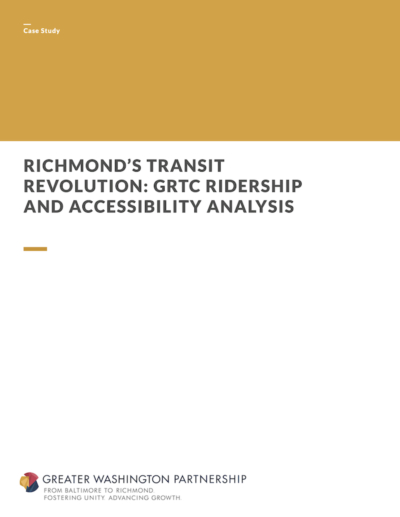 Download Report »
Download Report »
Executive Summary
Transit improvements have been successful in attracting riders and in providing greater access for the residents. Ridership across the GRTC system increased 17 percent from July 2018–April 2019, compared to the same period the year before—while transit ridership nationally declined by nearly two percent.
The Richmond metro area in Virginia is on its way to becoming a national transit leader. After many years of trailing its peers in transit service, Richmond has soared to the front of the pack—turning around its declining ridership with new services to meet the mobility needs of its residents. Home to over a million people in the city and surrounding counties, Richmond has increased ridership on its transit system—a feat that few metro areas in the United States have been able to accomplish in recent years.
Like other metro areas, Richmond has faced a growing population, decentralization of jobs, and limited transportation options. However, the City of Richmond, adjacent Henrico County, Greater Richmond Transit Company (GRTC; the metro area’s transit agency), and the Commonwealth of Virginia decided to take bold action. With support from a federal Transportation Investment Generating Economic Recovery (TIGER) grant, the Richmond metro area opened its first Bus Rapid Transit (BRT) line, launched a redesigned bus network in the city, and expanded bus service in Henrico County, all within a three-month period in 2018.
These were historic changes for Richmond’s transit system intended to provide better access to jobs, education, healthcare, and other services for the area’s residents, including disadvantaged groups and low-income households. How well the new network achieves this goal not only has implications for Richmond’s ability to create a dynamic, inclusive, and prosperous metro, but also provides important lessons for other metro areas working to provide modern mobility options for residents.
This case study analyzes Richmond’s recent transit improvements through an examination of ridership, access to transit, including frequent transit, and access to jobs via transit, before and after the historic expansion of GRTC’s system in 2018. Based on these metrics, the transit improvements have been successful in attracting riders and in providing greater access for the Richmond area residents. Ridership across the GRTC system increased 17 percent from July 2018–April 2019, compared to the same period the year before—while transit ridership nationally declined by nearly two percent. The analysis makes clear, however, that the benefits of these changes do not extend throughout the region. Though Richmond now has a head start compared to many of its peer metro areas, there is more work to do to advance an inclusive, comprehensive transportation system for the metro area.
